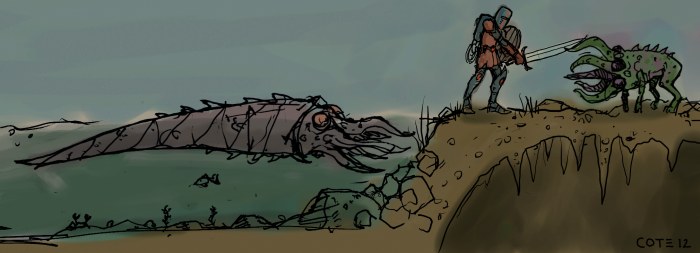
In the ongoing quest to quantify the imaginary, I found myself wondering if there's a way to approximate the weight of a monster. I came across an article at the University of Arizona's website which provides formulas used in the estimation of livestock weight. They seemed like they might be useful in the approximation of monster weights. For the math behind the formula, check out the article.
Basically, to approximate the weight, you need two cross sectional diameters and the length of the torso (in feet). We'll use the monsters in the above sketch as an example. The illustration depicts an intrepid adventurer fighting off a razorbacked wormhound while a giant orthoceras surfaces behind him. Depending on which way the combat goes, it's either crunchy monster snack time or the knight is going to be having king-size calamari for dinner.
We'll start with the orthoceras (my favorite extinct nautiloid cephalopod). If the adventurer is approximately 6' tall, then the orthoceras is approximately 18' long and has a cross sectional diameter of 3' at the front tapering towards the back. So the numbers we'll use in the calculator are: 3, 1 and 18. JavaScript crunches the math for us and we find that the giant orthoceras is approximately 2,302 lbs, which seems reasonable for an eighteen foot armored squid.
Now we'll turn to the wormhound. I'll approximate that the creature's torso is 3.5' in length and the relevant cross sectional diameters are 2' and 1'. Plugging those numbers into the calculator gives us an estimated weight of 298 lbs., which also seems reasonable.
Is this useful? Probably not. Are these results scientifically accurate? No. Are they based on real world principles? Certainly. But when your gaming group insists on dragging that monster corpse back to town to the village taxidermist as a trophy, you can give them an idea as to how difficult the task will actually be.
Bibliography:
Pater, Susan. "How Much Does Your Animal Weigh?" Backyards & Beyond. 1.3 (2007): 11-12. Print.
